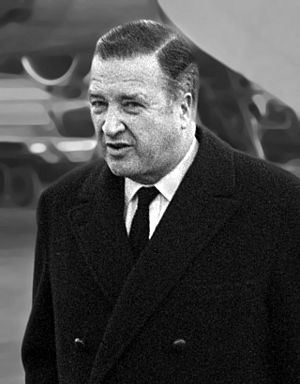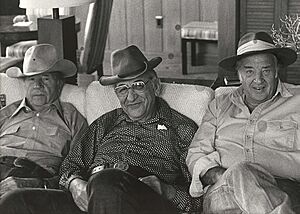Henry Ford II facts for kids
Quick facts for kids
Henry Ford II
|
|
|---|---|

Ford in 1963
|
|
| Born | September 4, 1917 Detroit, Michigan, U.S.
|
| Died | September 29, 1987 (aged 70) Detroit, Michigan, U.S.
|
| Education | Yale University (did not graduate) |
| Occupation | Automobile executive |
| Title |
|
| Spouse(s) |
|
| Children |
|
| Parent(s) | Edsel Ford (father) |
| Relatives |
|
| Chairman of the Ford Motor Company | |
| In office July 13, 1960 – March 13, 1980 |
|
| Preceded by | Ernest Breech |
| Succeeded by | Philip Caldwell |
| President of the Ford Motor Company | |
| In office September 21, 1945 – November 9, 1960 |
|
| Preceded by | Henry Ford |
| Succeeded by | Robert McNamara |
Henry Ford II (born September 4, 1917 – died September 29, 1987) was an important American businessman. He worked in the automotive industry, which makes cars. People sometimes called him "Hank the Deuce" or "the Deuce."
Henry Ford II was the oldest son of Edsel Ford and the oldest grandson of Henry Ford, who started the famous Ford Motor Company. Henry Ford II led the company as its president from 1945 to 1960. He was also the Chief Executive Officer (CEO) from 1947 to 1979. From 1960 to 1980, he served as the chairman of the company's board of directors. Under his leadership, Ford Motor Company became a company whose shares could be bought and sold by the public in 1956.
Contents
Early Life and School
Henry Ford II was born in Detroit, Michigan, on September 4, 1917. His parents were Eleanor Clay Ford and Edsel Ford. He grew up in a wealthy family with his brothers, Benson and William, and his sister, Josephine.
He went to The Hotchkiss School and finished there in 1936. Later, he attended Yale University. While at Yale, he worked for The Yale Record, which was the campus humor magazine. He left Yale in 1940 before he could graduate.
Leading the Ford Company
Henry Ford II's father, Edsel Ford, was the president of Ford. Edsel died in May 1943 during World War II. At that time, Henry Ford II was serving in the Navy. This meant he could not immediately take over as president of the family business.
His grandfather, Henry Ford I, who founded the company, took back the role of president. However, the elder Henry Ford was getting old and sick. Many of the company's leaders felt he was no longer fit to be president. Even so, the company's board of directors chose him to lead. He stayed in charge until the end of the war. During this time, the company faced big problems and lost a lot of money each month. The government even thought about taking over the company to make sure it kept producing for the war effort.
Henry Ford II left the Navy in July 1943. He joined the company's management a few weeks later. He officially became the president of Ford Motor Company on September 21, 1945. He had not been prepared much for this big job. He took over the company during a very difficult time. Ford's factories in Europe were badly damaged by the war. Also, car sales in the U.S. were going down.
New Leadership and Ideas
Henry Ford II quickly started to make big changes. One of his first actions was to put John Bugas in charge of managing the company. He also let go of many people who were close to his grandfather. This included Harry Bennett, who had been in charge of security and had tried to stop workers from forming unions.
Henry Ford II knew he needed help because he was new to the job. So, he hired experienced business leaders. He brought in Ernest Breech and Lewis Crusoe from another company. Breech became a mentor to the young Ford. The team of Breech and Crusoe brought much-needed experience to the company.
Ford also hired ten smart young people. They were known as the "Whiz Kids." These ten people came from a statistics team in the Army Air Forces. Henry Ford II believed they would help the company create new ideas and stay modern. Two of them, Arjay Miller and Robert McNamara, later became presidents of Ford themselves. Another member, J. Edward Lundy, worked in important financial roles for many years.
The "Whiz Kids" are best known for designing the 1949 Ford car. They took it from an idea to a finished car in just 19 months. This car helped Ford become a strong car company again. It was reported that 100,000 orders for this car were placed on the very first day it was available!
Company Growth and Changes
Henry Ford II became president and CEO of Ford Motor Company in 1945. In 1956, the company started selling its shares to the public. This raised a lot of money for the company. Also in 1956, Ford opened its new world headquarters building.
He lived in Grosse Pointe, Michigan, while he was CEO. On July 13, 1960, he was chosen as chairman. He stepped down as president on November 9, 1960. He left his CEO role on October 1, 1979, and his chairman role on March 13, 1980. Later, his nephew, William Clay Ford, Jr., took on these roles.
Racing and Car Design
In the early 1960s, Ford tried to buy Ferrari, a famous Italian car company. He wanted Ford to be more involved in car racing, especially in the Le Mans 24 Hours race. However, the deal fell apart because they disagreed about who would control Ferrari's racing team.
Because the deal failed, Henry Ford II started the Ford GT40 project. His goal was to end Ferrari's winning streak at Le Mans. Ferrari had won the race six times in a row from 1960 to 1965. In 1966, after two tough years, the Ford GT40 Mark II cars won the top three spots at the Daytona 24 Hours and the Sebring 12 Hours. Then, they took the first of four wins in a row at Le Mans.
In the late 1960s, Henry Ford II personally helped create the Lincoln Continental Mark III. He made design choices even if they went against what focus groups (groups of people giving opinions) or Ford engineers suggested. He chose the final look for both the outside and inside of the car. This car became a huge success for Ford. It made the Lincoln brand profitable and started a long competition between the Lincoln Mark series and Cadillac's Eldorado cars. The success of the Mark III is seen as a high point in Ford's career.
During this time, Ford also changed how the company worked in Europe. He combined the separate British and German Ford companies into one Ford of Europe. This meant they would have common car models and shared factories. In the 1970s, Ford of Europe grew a lot, opening new factories in places like Saarlouis and Valencia.
Challenges and Decisions
In the early 1970s, it became clear that American car buyers would want smaller, more fuel-efficient cars. Lee Iacocca, who was president of Ford at the time, wanted to buy engines from Honda Motor Company. This would help Ford make a small car for the North American market, like a changed version of the Ford Fiesta from Europe.
However, Henry Ford II rejected this idea. He famously said, "No car with my name on the hood is going to have a Jap engine inside." Even though Ford Motor Company had been selling a Mazda pickup truck called the Ford Courier since 1971, Henry Ford II did not like the idea of major Ford passenger cars using engines from Japan. Eventually, Ford Motor Company did adapt to a world where car companies from Japan, Germany, and America worked closely together. For example, Ford's relationship with Mazda grew strong even before Henry Ford II left his powerful position.
Henry Ford II's way of managing caused the company's success to go up and down. For example, he allowed the company to offer public stock in 1956, which brought in a lot of money. But an "experimental car" program during his time, called the Edsel, cost the company almost half of that amount.
He also hired the very creative Iacocca, who was key to the success of the Ford Mustang in 1964. But Henry Ford II fired Iacocca in 1978 because of personal disagreements. Iacocca later said that Ford told him, "Sometimes you just don't like somebody."
Henry Ford II officially retired from all his roles at Ford Motor Company on October 1, 1982. He had reached the company's required retirement age of 65. However, he remained a very important person at Ford until he passed away in 1987.
Awards and Achievements
- In 1969, he received the Presidential Medal of Freedom from President Lyndon B. Johnson. This is a very high honor in the United States.
- In 1983, he was added to the Automotive Hall of Fame, which recognizes important people in the car industry.
Personal Life
Henry Ford II was married three times:
- Anne McDonnell (1919–1996): They married in 1940 and divorced in 1964. They had three children:
- Charlotte Ford
- Anne Ford
- Edsel Ford II
- Maria Cristina Vettore (1929–2008): She and Ford married in New York City in 1965 and divorced in 1980.
- Kathleen DuRoss (1940 - 2020): She and Ford were married in Carson City, Nevada, in 1980. Through this marriage, Ford had two stepdaughters:
- Deborah Guibord
- Kimberly DuRoss
Henry Ford II died from pneumonia in Detroit on September 29, 1987. He was 70 years old. After a private funeral, his body was cremated, and his ashes were scattered.
Legacy
- The Henry Ford II World Center is the official name for the Ford World Headquarters building in Dearborn, Michigan.
- The Henry Ford II Honors Program is the special honors program at Henry Ford College.
- Henry Ford II High School, located in Sterling Heights, Michigan, is named after him.
Filmography
- The Ford 50th Anniversary Show (1953) - This was a TV show that was broadcast live. It was called a "landmark in television."
- Thunderball (1965) – He appeared as an extra (a background person) in the Nassau Casino scene. His role was not credited.
See also
 In Spanish: Henry Ford II para niños
In Spanish: Henry Ford II para niños
- Ford family tree
- Ford Foundation


